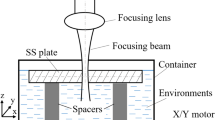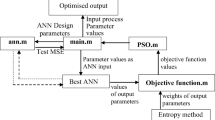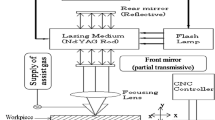Abstract
Laser assisted oxygen cutting (LASOX) process is an efficient method for cutting thick mild steel plates compared to conventional laser cutting process. However, scanty information is available as to modeling of the process. The paper presents an optimized SA-ANN model of artificial neural network (ANN) and simulated annealing (SA) to predict and optimize cutting quality of LASOX cutting process of mild steel plates. Optimization of SA-ANN parameters is carried out first where the ANN architecture and initial temperature for SA are optimized. The optimized ANN architecture is further trained using single hidden layer back propagation neural network (BPNN) with Bayesian regularization (BR). The trained ANN is then used to evaluate the objective function during optimization with SA. Experimental dataset employed for the purpose consists of input cutting parameters comprising laser power, cutting speed, gas pressure and stand-off distance while the resulting cutting quality is represented by heat affected zone (HAZ) width, kerf width and surface roughness. Results indicate that the SA-ANN model can predict the optimized output with reasonably good accuracy (around 3%). The proposed approach can be extended for prediction and optimization of operational parameters with reasonable accuracy for any experimental dataset.








Similar content being viewed by others
Abbreviations
- ANN:
-
Artificial neural networks
- SA:
-
Simulated annealing
- LASOX:
-
Laser assisted oxygen cutting
- GA:
-
Genetic algorithm
- BPNN:
-
Back propagation neural network
- LM:
-
Levenberg Marquardt algorithm
- BR:
-
Bayesian regularization
- V:
-
Cutting speed (mm/min)
- PR:
-
Gas pressure (bar)
- P:
-
Laser power (W)
- F:
-
Stand off distance (mm)
- HAZ:
-
Heat affected zone
- H:
-
HAZ width (mm)
- K:
-
Kerf width (mm)
- R:
-
Surface roughness (μm)
- X :
-
Input vector, \( {\mathbf{X}} = \left[ {\begin{array}{*{20}c} {\text{V}} & {\text{PR}} & {\text{P}} & {\text{F}} \\ \end{array} } \right] \)
- D :
-
Output vector, \( {\mathbf{D}} = \left[ {\begin{array}{*{20}c} {\text{H}} & {\text{K}} & {\text{R}} \\ \end{array} } \right] \)
- J :
-
Cutting quality factor of LASOX cutting
- HLN:
-
Hidden layer neurons in ANN
- T:
-
Initial temperature for SA
- S :
-
A solution point of quasi-Newton search algorithm, \( {\mathbf{S}} = \left[ {\begin{array}{*{20}c} {{\mathbf{HLN}}} & {\mathbf{T}} \\ \end{array} } \right] \)
- H:
-
Hessian matrix
- BFGS:
-
Broyden-Fletcher-Goldfrad-Shanno updating formula
- X max , X min :
-
Maximum and minimum real values of input
- D max :
-
Maximum real values of output
- X nor , T nor :
-
Normalized input and output vector
- w :
-
Weight vector associated with hidden layer neurons
- M:
-
Activation value of hidden layer neurons
- Z:
-
Output signals of hidden layer neurons
- O :
-
Output signal of the network
- SSE :
-
Sum of the squared errors
- SSW :
-
Sum of the squared weights
- Φ :
-
A factor indicates a linear combination of SSE and SSW
- α, β:
-
Regularization parameters
- MSE:
-
Mean of squared errors
- E:
-
Energy state in simulated annealing algorithm
- k:
-
Boltzmann constant or cooling rate
- N :
-
A solution point of SA optimisation
- t:
-
Iteration count for SA
- r:
-
Random number between 0 and 1
References
Neill WO, Gabzdyl JT (2000) New developments in oxygen-assisted laser cutting. J Opt Lasers Eng 34:355–367
Molian PA (1993) Dual-beam CO2 laser cutting of thick metallic materials. J Mater Sci 28:1738–1748
Alfille JP, Pilot G, De Prunele D (1996) New pulsed YAG laser performances in cutting thick metallic materials for nuclear applications. Proc SPIE 134–144
Fukaya K, Karube N (1990) Analysis of CO2 laser beam suitable for thick metal cutting. Laser Inst Am 71:61–70
Sundar M, Nath AK, Bandyopadhyay DK, Chaudhuri SP, Dey PK, Misra D (2009) Effect of process parameters on the cutting quality in Lasox cutting of mild steel. Int J Adv Manuf Technol 40:865–874
Haykin S (2006) Neural networks: a comprehensive foundation. Pearson Education Inc, India
Hornik K, Tinchcombe M, White H (1989) Multilayer feed forward networks are universal approximators. IEEE Trans Neural Netw 2:359–366
Hagan MT, Menhaj MB (1994) Training feed forward networks with the Marquardt Algorithm. IEEE Trans Neural Netw 5(6):989–993
Van Der Smagt P (1994) Minimization methods for training feed forward neural networks. IEEE Trans Neural Netw 7(1):1–11
Yousef BF, Knopf GK, Bordatchev EV, Nikumb SK (2003) Neural network modeling and analysis of the material removal process during laser machining. Int J Adv Manuf Technol 22(1–2):41–53
Galantucci LM, Tricarico L, Spina R (2000) A quality evaluation method for laser welding of Al alloys through neural networks. Ann ClRP 49(1):131–134
Casalino G, Curcio F, Memola Capece Minutolo F (2005) Investigation on Ti6Al4V laser welding using statistical and Taguchi approaches. J Mater Process Technol 167:422–428
Missori S, Sili A, Ucciardello N (2008) Process parameters optimization of laser beam welded joints by neural Network. Mater Manuf Process 23(2):168–173
Widrow B, Lehr MA (1990) 30 Years of adaptive neural networks: perceptron, madline and backpropagation. Proc IEEE 78(9):1415–1442
Foresee FD, Hagan MT (1997) Gauss–Newton approximation to Bayesian learning. In: Proceedings of international joint conference on neural networks, pp 1930–1935
Caydas U, Hascalik A (2008) Use of the grey relational analysis to determine optimum laser cutting parameters with multi-performance characteristics. Opt Laser Technol 40:987–994
Almeida IA, de Rossi W, Lima MSF, Berretta JR, Nogueira GEC, Wetter NU, Vieira ND Jr (2006) Optimization of titanium cutting by factorial analysis of the pulsed Nd:YAG laser parameters. J Mater Process Technol 179:105–110
Petring D (2009) Calculable laser cutting. In: Proceedings of the 5th international WLT-conference on lasers in manufacturing, Munich, 15–18 June 2009, Stuttgart, pp 209–214
Tsai M-J, Li C-H, Chena C-C (2008) Optimal laser-cutting parameters for QFN packages by utilizing artificial neural networks and genetic algorithm. J Mater Process Technol. doi:10.1016/j.jmatprotec.2007.12.138
Park YW, Rhee S (2008) Process modeling and parameter optimization using neural network and genetic algorithms for aluminum laser welding automation. Int J Adv Manuf Technol 37:1014–1021
Jang J-SR, Sun C-T, Mizutani E (2007) Neuro-fuzzy and soft computing: a computational approach to learning and machine intelligence. Pearson Education Inc, India
Deb K (2005) Optimization for engineering design: algorithms and examples. Prentice-Hall of India Private Limited
Author information
Authors and Affiliations
Corresponding author
Rights and permissions
About this article
Cite this article
Chaki, S., Ghosal, S. Application of an optimized SA-ANN hybrid model for parametric modeling and optimization of LASOX cutting of mild steel. Prod. Eng. Res. Devel. 5, 251–262 (2011). https://doi.org/10.1007/s11740-011-0298-x
Received:
Accepted:
Published:
Issue Date:
DOI: https://doi.org/10.1007/s11740-011-0298-x




